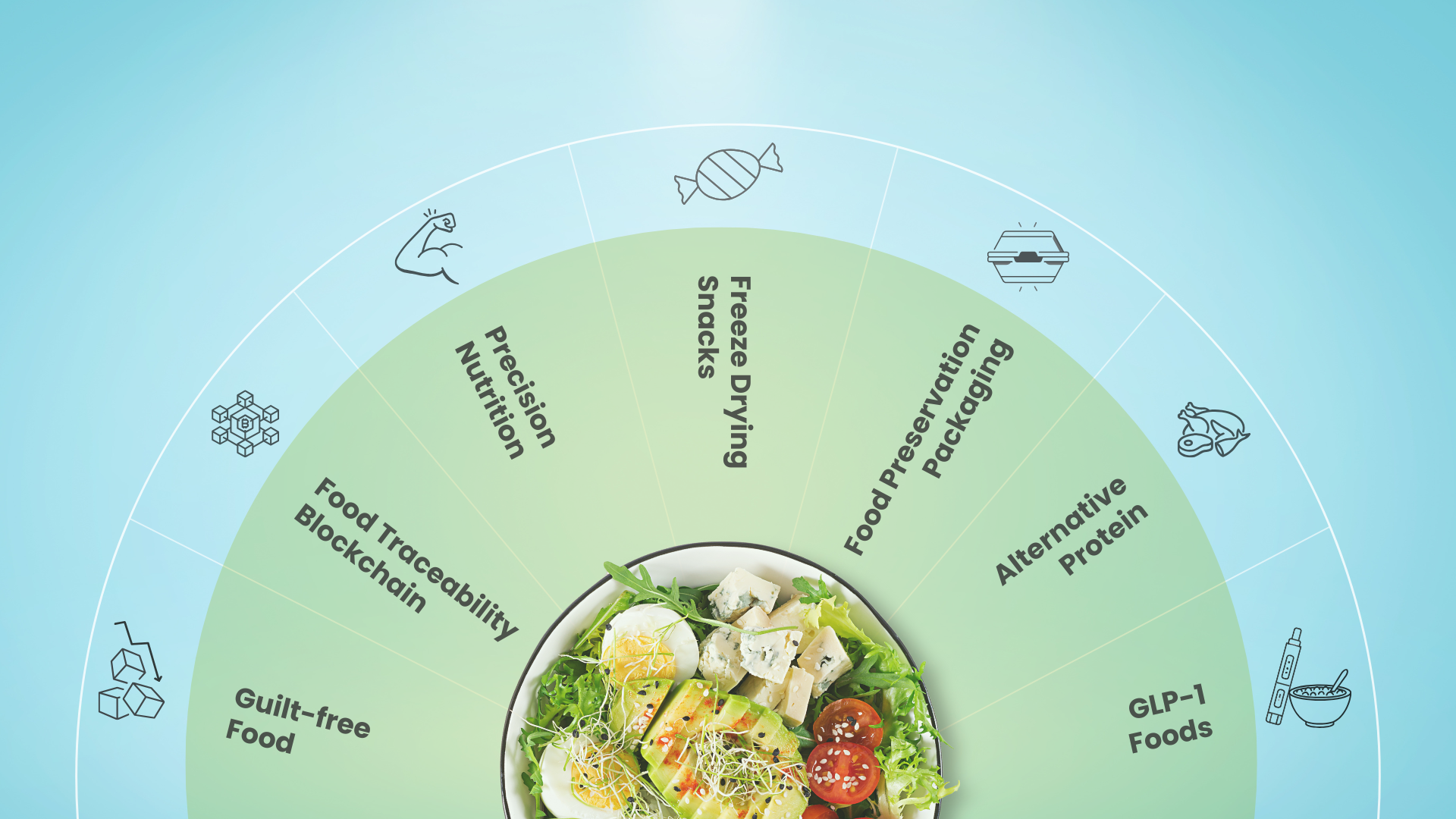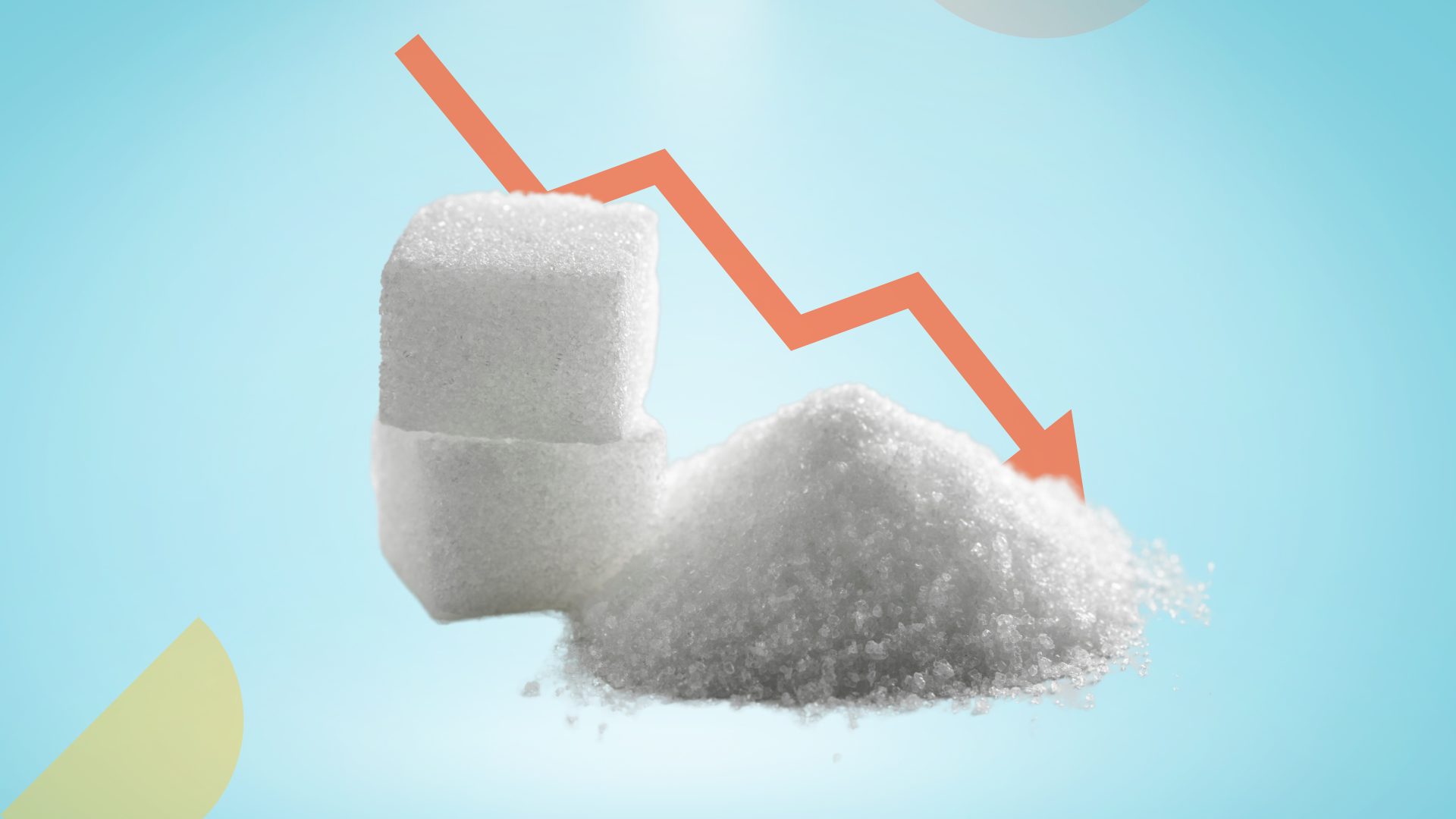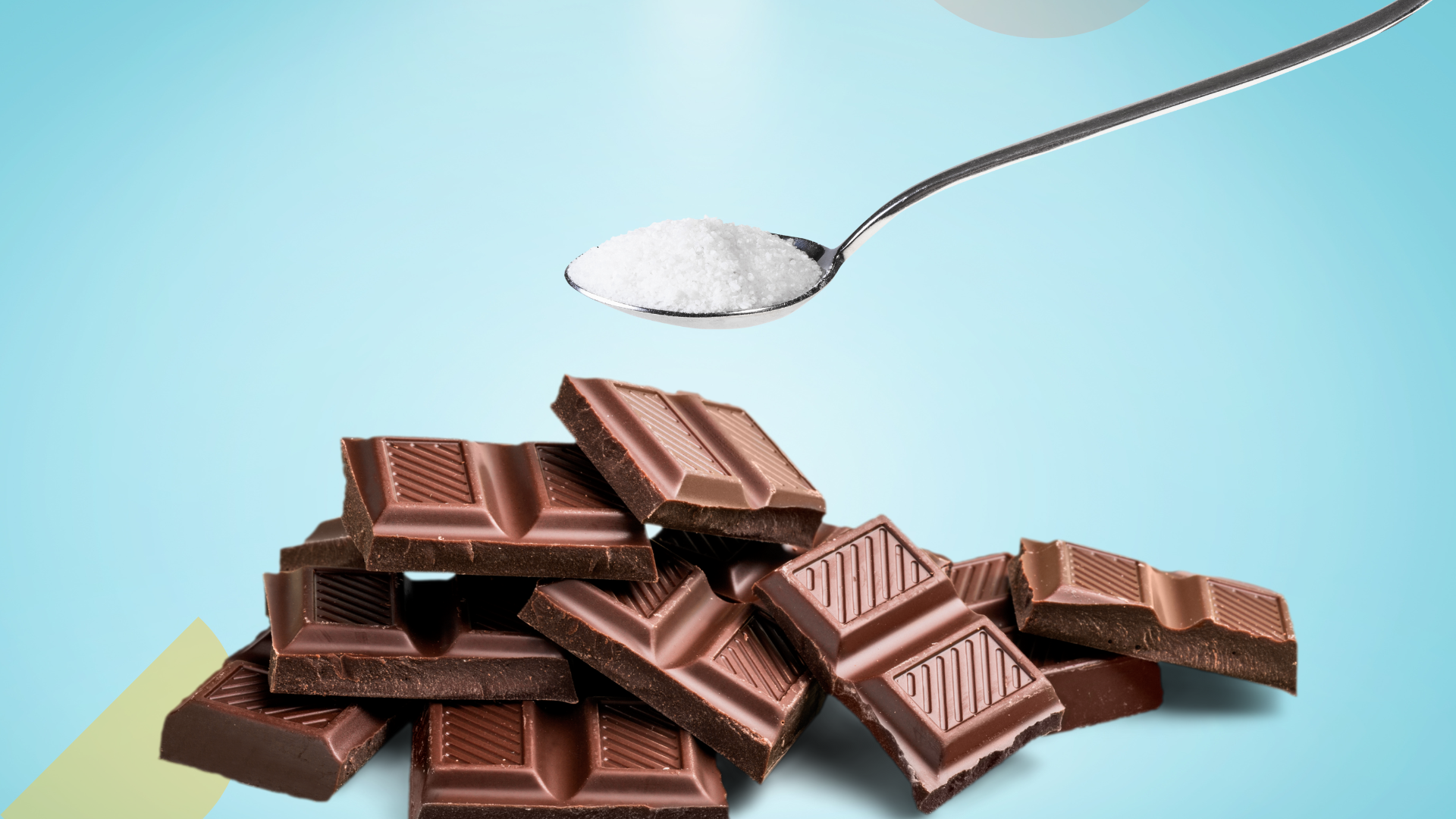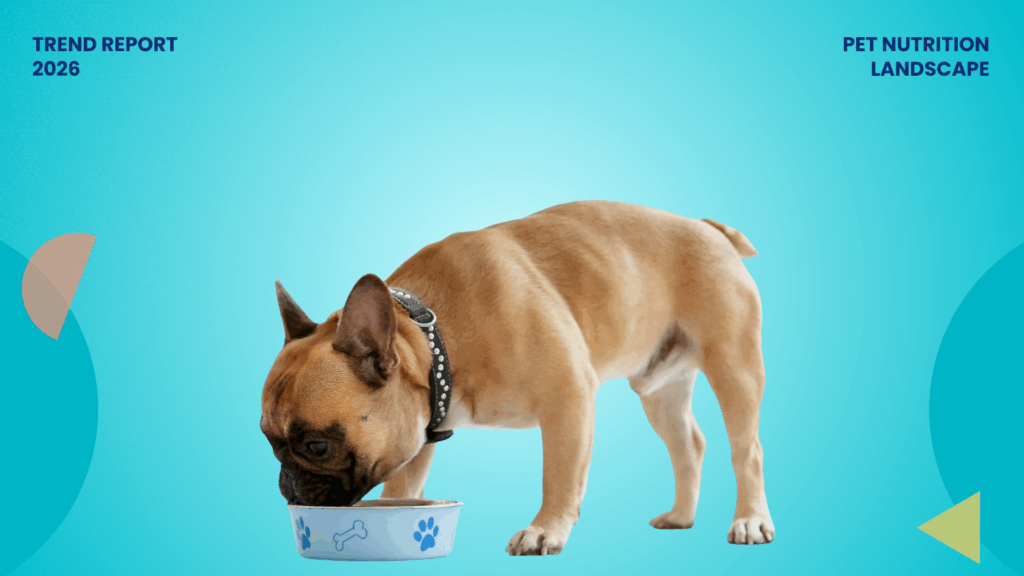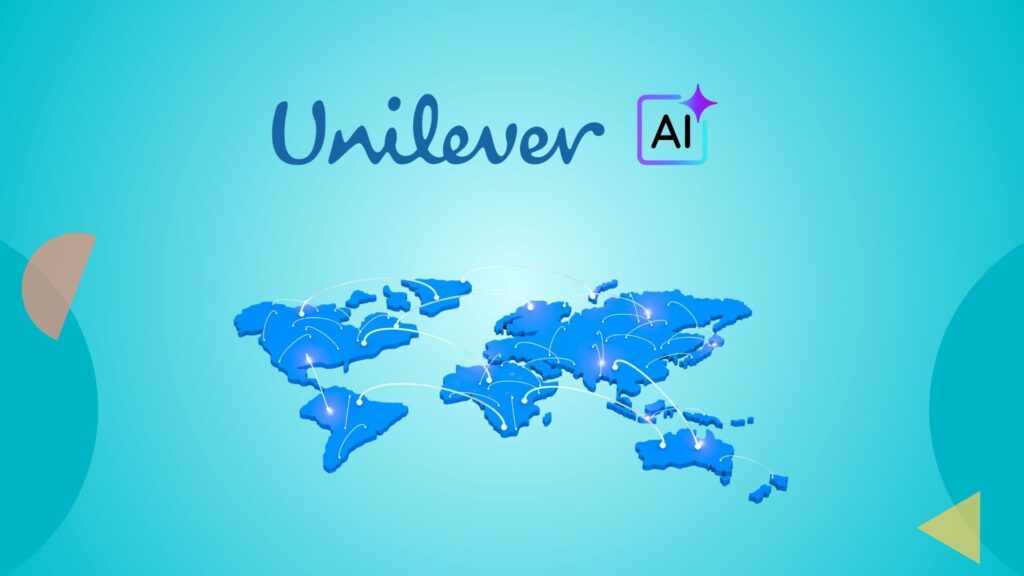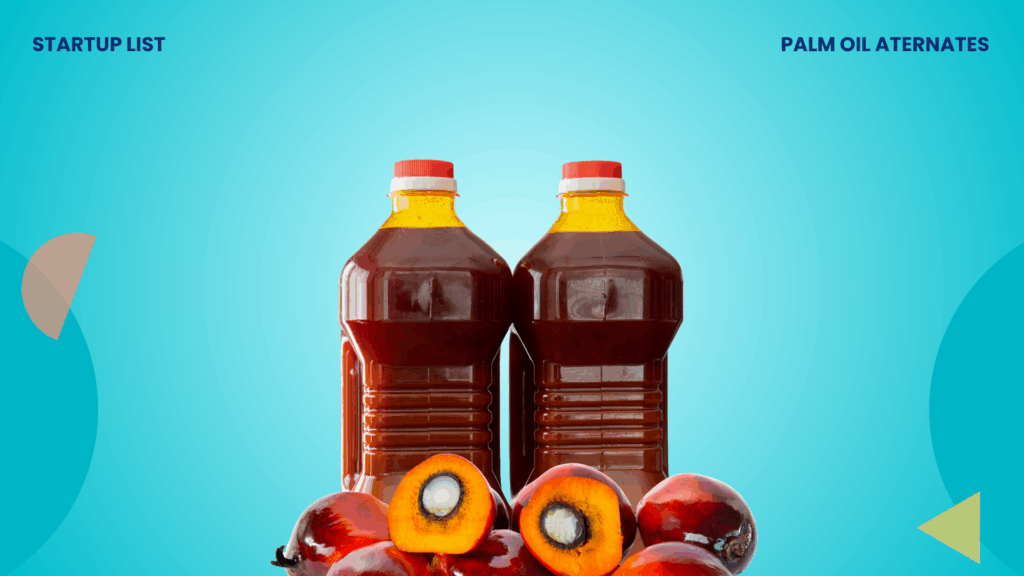F&B experts hardly took notice when GLP-1 drugs first entered the market. “I don’t think it is going to be the wild, dramatic impact being suggested,” remarked Rick Miller, the associate director of food and drink research at Mintel, echoing the broader sentiment that these drugs wouldn’t rattle the food ecosystem.
Today, the numbers tell a different story. Spending on savory snacks by GLP-1 users in the US has dropped by up to 11%, well ahead of Morgan Stanley’s long-term prediction of a 3% overall drop by 2035.
Now, food companies are rushing to reformulate, leaning into nutrient-dense, protein-forward, and sugar-conscious offerings.
If a pharmaceutical trend could create ripple effects across the food landscape, what other undercurrents will quietly reshape what consumers eat next?
This article discusses seven such global food trends, including freeze-dried treats, AI-powered personalized nutrition, and alternative protein sources, that could catch the industry off guard, again.
Our 2026 Food Trends study dives into market analysis, patent activity, emerging technologies, and rising startups to identify the key food trends R&D teams shouldn’t miss. The report highlights brands and innovations leading these trends, providing you with a clear roadmap of where the industry is headed. This report will help you spot new growth opportunities and develop products that resonate with future consumers.
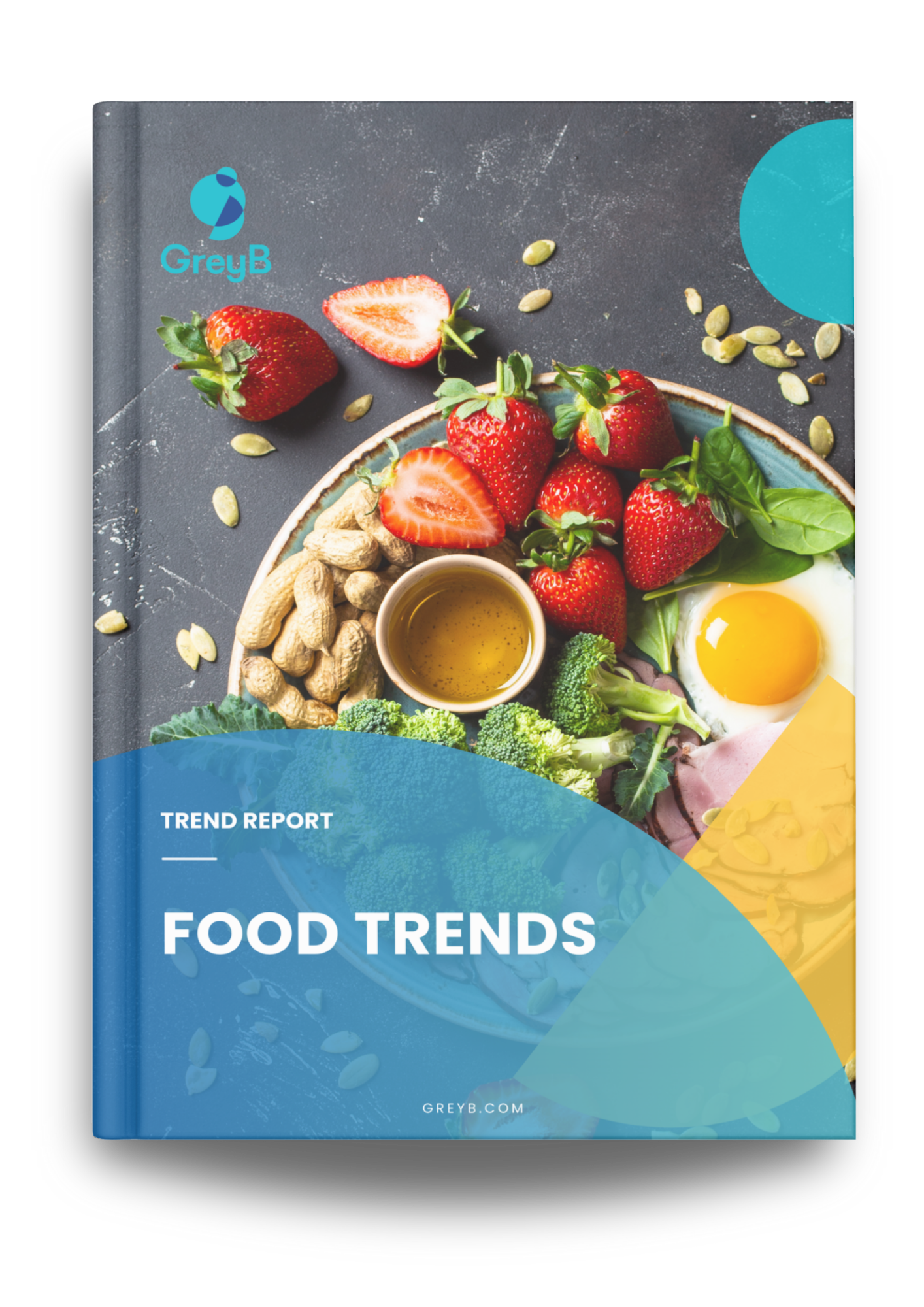
1. Novel Freeze-Dried Candy and Snacks
“#Freezedriedcandy” garnered over 4.7 billion views on TikTok early this year, indicating significant consumer interest in this domain. These candies are gaining popularity for their unique crunchy texture and intensified flavors.
Candy giant Jolly Rancher has freeze-dried its most popular flavors like green apple, watermelon, and blue raspberry, to cater to this food trend.
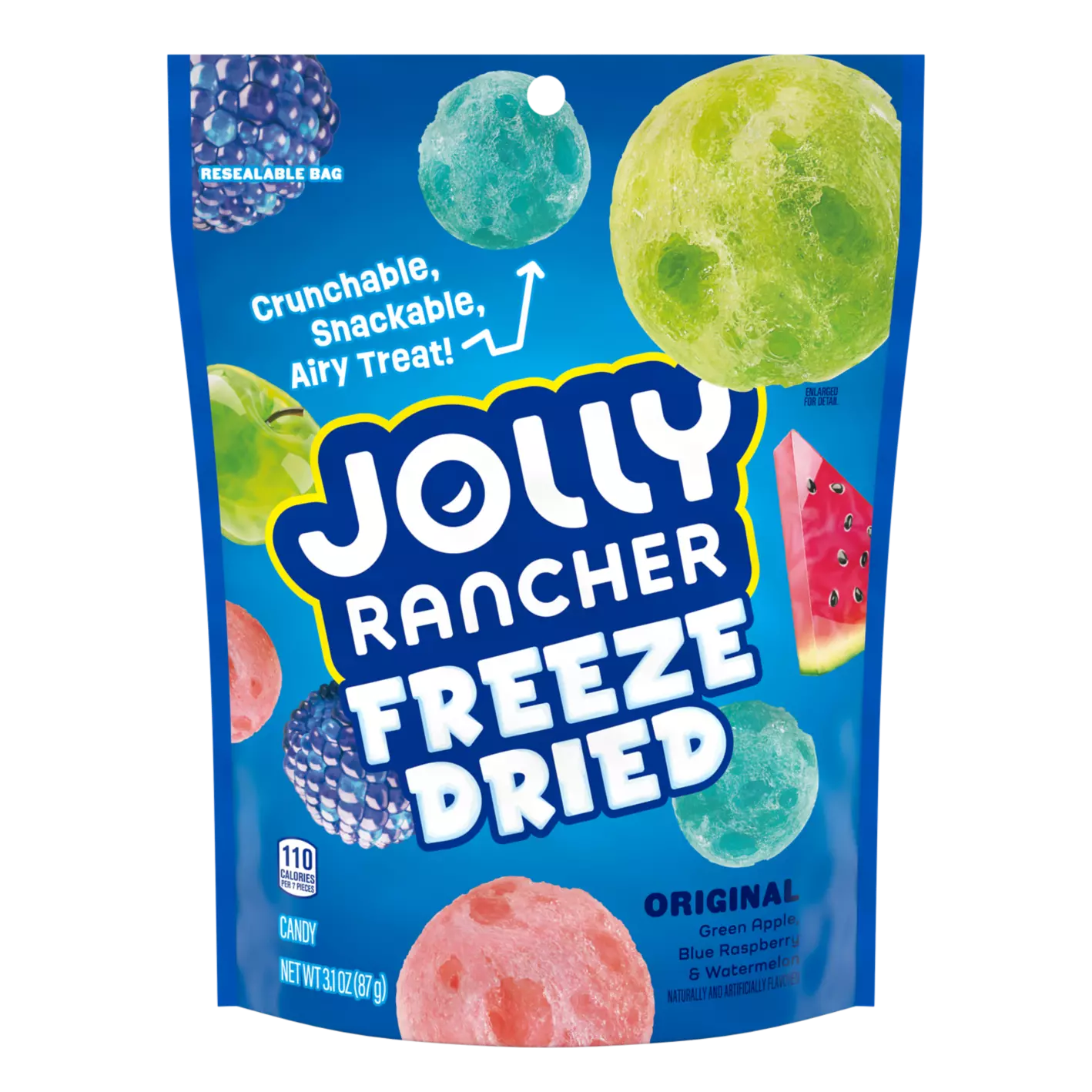
TikTok-famous Sweety Treaty Co.’s gained popularity in this category. The brand offers freeze-dried versions of popular treats like Jolly Puffs, Milk Dudes, and Sour Worms.
However, the high cost of freeze-drying equipment and processing remains a significant challenge to the segment’s growth. It creates barriers for SMEs to enter the market. Additionally, freeze-drying causes the loss of certain nutrients, such as vitamin C, reducing the nutritional value of the final product. But companies like Melt & Jet have developed technologies that preserve these nutritional values.
Melt & Jet’s freeze-drying technology preserves 98% of the nutrients from fruits and vegetables
Melt & Jet’s freeze-dried nutricosmetics melt in your mouth, offering a convenient and enjoyable way to consume supplements for skin and hair without the need for water or swallowing pills. These fast-dissolving tablets are called “JETS.” They comprise at least 10% fruit and/or vegetable puree, and at least 0.5% of an exogenous nutricosmetic (such as vitamins, minerals, collagen, hyaluronic acid, and other beneficial compounds).
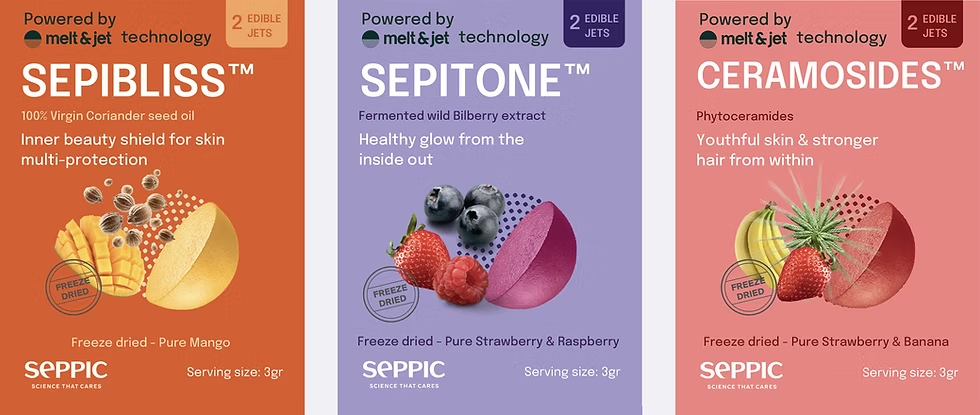
The core technology lies in Melt & Jet’s proprietary freeze-drying process. It retains 98% of the nutrients, significantly more than conventional methods. Jets are clean-label products free from unnecessary additives, gelatin, sugars, or artificial colors.
Melt & Jet operates a robust B2B model, offering customizable supplement delivery systems to established brands and retailers. Clients can develop custom-made formulas or choose from the brand’s tested, ready-made solutions for energy, beauty, and brain health.
Freezecake enables you to enjoy gourmet cheesecake anytime, anywhere
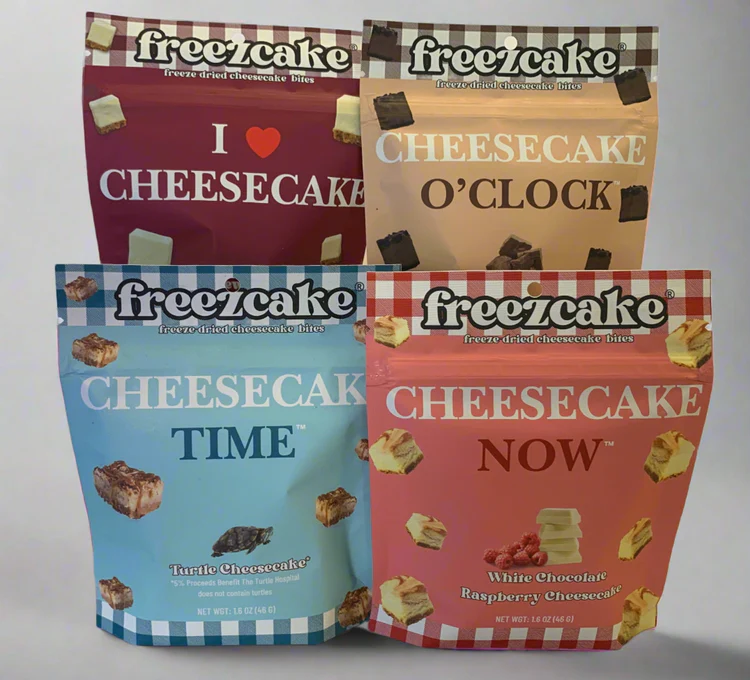
Until now, freeze-dried food had recalled memories of bland, crunchy backpacking meals, such as beef stew and chicken noodle soup. But this perception is changing. We’re entering a delicious new era of freeze-dried delights.
Florida-based Freezcake is redefining this category with cheesecake bites. Their product range features an array of flavors. These include classic New York Cheesecake, indulgent Turtle Cheesecake, fruity Strawberry Cheesecake, and seasonal delights like Eggnog and Caramel Apple.
Made with ingredients such as cream cheese, eggs, and natural sweeteners, these treats are free from preservatives and artificial flavors. The freeze-drying process preserves the rich taste and creamy texture of traditional cheesecake. It transforms cheesecake into a shelf-stable, portable snack ideal for any adventure, including hiking. Here’s what the customers have to say about it:

2. AI-powered Precision Nutrition
As precision medicine advances to tailor treatments to individual needs, precision nutrition is also gaining momentum. It is focused on personalized dietary recommendations based on users’ unique health profiles.
This concept is also making waves in the interdisciplinary field of sports science. Companies like DSS Sports Group are developing innovative systems that create personalized nutritional strategies for athletes. This system enhances athletic performance by utilizing the athlete’s biometric data and physique goals. In fact, food companies have also created customized products that help Esports athletes to stay focused and energized.
Consumers are increasingly becoming open to sharing health data via smart devices in exchange for customized diet and nutrition plans. A recent survey revealed that 62% of U.S. consumers are comfortable sharing health data from their wearable devices with general practitioners. Recognizing this opportunity, numerous startups and industry leaders have developed nutrition and wellness systems that make customized diets for users.
Discover Precision Nutrition Innovations
MealMeter uses multimodal sensing and machine learning to estimate macronutrient intake
Self-reported food logs and dietary recalls are not only time-consuming but also frequently inaccurate and biased. A study shows that individuals tend to underreport their calorie intake by 15–34% while overestimating their nutrient consumption. These inconsistencies pose a significant barrier to precision nutrition, where accurate assessment of meal macronutrient content is essential for personalized dietary recommendations.
A team led by Asiful Arefeen at Arizona State University has created a system called MealMeter to measure macronutrients like carbohydrates, proteins, and fats using wearable devices.
It uses a combination of physiological signals (e.g., heart rate, blood glucose levels), inertial motion data, and environmental cues to model metabolic responses after meals. Using this approach, the system records what the user ate, eliminating the need for self-reported food logs.

The model demonstrated impressive performance in estimating carbohydrate and fat intake, with Mean Absolute Errors (MAE) of 13.2g for carbohydrates and 3.67g for fat. Protein estimation was challenging, with MAE ranging from 2.93g to 18.4g.
It shows promise in automating meal tracking for precision nutrition. It has the potential to aid individuals managing metabolic disorders such as diabetes and obesity. The research team plans to expand the system’s capabilities for real-world, free-living applications. This includes the incorporation of stress-level tracking to enhance dietary assessment and metabolic health monitoring.
Brightseed AI helps brands discover bioactive compounds to optimize their precision nutrition products
Despite the vast array of bioactive compounds present in plants and microbes, fewer than 1% have been identified. This lack of data limits the use of bioactive compounds in products and diets made using precision nutrition.
Brightseed is overcoming this industry challenge with its proprietary Forager® AI platform. This year’s best innovation of 2024 has mapped 7 million plant compounds and identified 40,000 predicted bioactives.
The SaaS solution enables brands to identify previously unknown plant sources of clinically validated bioactives. It also constructs a digital model of human biology to understand how these bioactives interact with the gut microbiome.
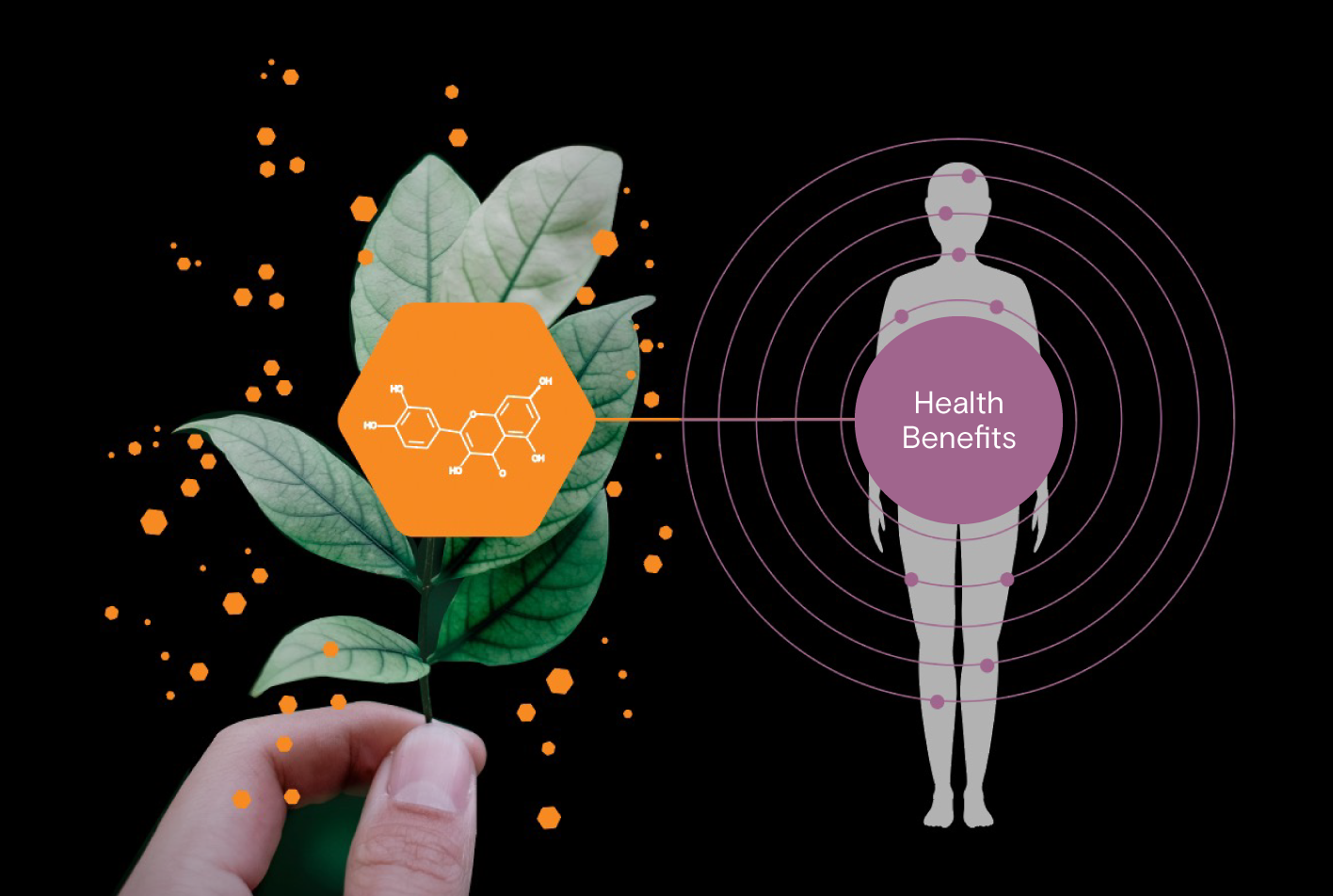
By leveraging Forager, brands can create differentiated products and formulations with proven health benefits. This helps them stand out in the market by making compelling health claims backed by science. In 2023, Blue Diamond partnered with Brightseed to explore the potential of bioactives in their California almonds. They identified 188 previously unrecognized bioactive compounds leveraging Forager.
“As an almond-focused grower cooperative and an innovation leader in almond-based ingredients and consumer products, we are thrilled to collaborate with Brightseed to gain a deeper understanding of this unique superfood.”
– Blue Diamond’s senior director of R&D, Kurt Waananen
Better & Better Co’s smart system is adding supplements to the everyday products of the user
Personal care company Better & Better Co. has developed a smart system that reimagines how people consume nutritional supplements. Instead of pills or capsules, the system makes invisible additions to everyday products for the user’s convenience. Whether it’s toothpaste, chewing gum, or lotion, this approach ensures that supplements are integrated seamlessly into a user’s routine. This eliminates the need to develop a new habit of taking supplements.
The patented system works by analyzing personal health data, such as blood test results, to detect deficiencies like low levels of Vitamin D or magnesium. Using this data, it determines which supplement is needed and how it is best absorbed (orally, through the skin, etc.). The system then matches this data with a product that the consumer already uses regularly. For instance, if someone brushes their teeth twice a day, the system may recommend adding the required supplement to their toothpaste.
The system works with infusion devices and delivery services like Amazon to ensure accurate dosing and easy access. It also defines a “consumption period” (e.g., 30 days for a toothpaste tube) and monitors whether the supplemented product produced positive health outcomes for the user. This creates an iterative feedback loop.
This process makes supplement consumption effortless and compliant; users don’t need to remember to take pills. They just go about their daily routines, and the supplements are delivered passively through products they already use. These are just a few advancements in the precision nutrition space.
The category is flooded with innovations, with novel nutrient intake prediction models, food image recognition systems, and microbiome analysis algorithms. Our in-house AI tool, Slate, can help you keep up with such R&D activities. Just ask, “What are the latest advancements in AI and ML for precision nutrition and functional food?” and speed up your research process.
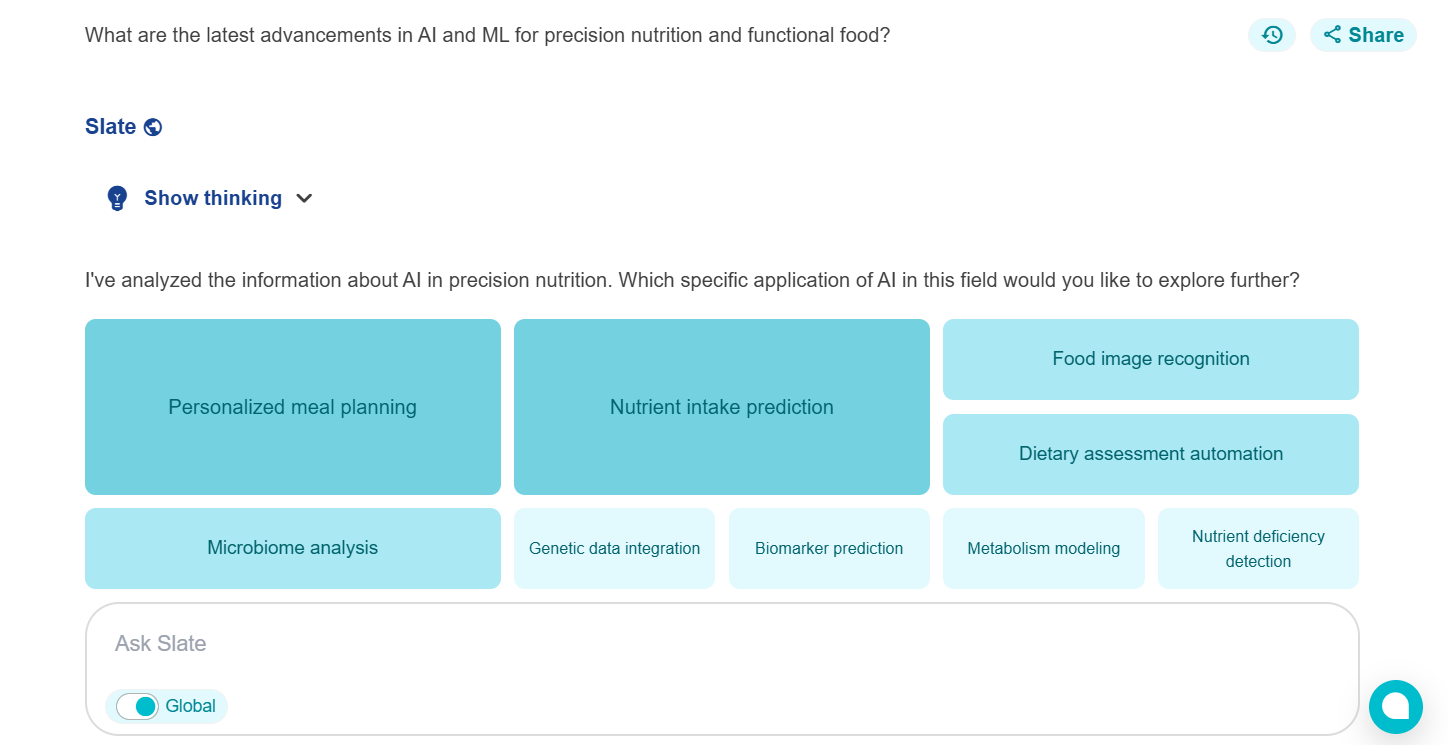
What are the latest innovations in precision nutrition?
3. Growing Demand For Guilt-free Food: People are ditching sugar, salt, and calories
We all love a good treat, but today’s consumers want more than just indulgence. They’re looking for snacks and sweets that hit the comfort spot while supporting their healthy lifestyles. Sure, there will always be moments to go all-in (like holidays or special occasions). However, for everyday cravings, the shift is clear: better-for-you options are on the rise.
Around the world, over one in five people are actively choosing foods with less salt, sugar, and fat, and this trend is growing stronger in higher age groups.
Big brands are responding. PepsiCo has cut saturated fat in Lay’s chips by 50% in China. Meanwhile, Hershey has doubled down on its better-for-you category to create more choices for consumers.
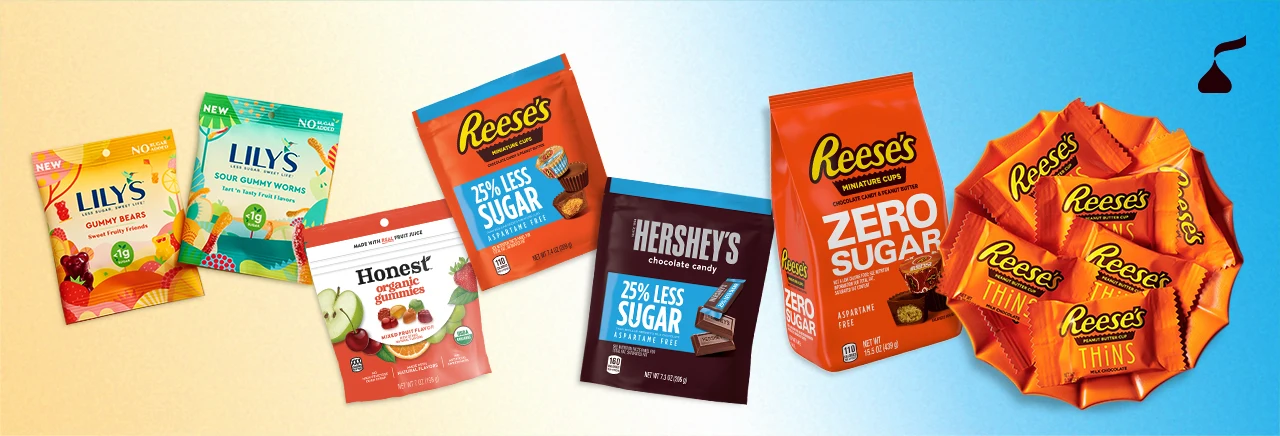
Kirin’s electronic spoon shocks your tongue to enhance flavour
Japanese company Kirin Holdings made headlines at CES 2025 with its electric salt spoon, which enhances the flavor of food by applying an electric current to the tongue. The weak electric current concentrates sodium ion molecules in food, enhancing the umami and salt flavors in low-sodium foods. This promotes healthier eating habits by allowing consumers to reduce their salt intake without compromising the taste of low-sodium food.
Tech journalist Kate Kozuch from Tom’s Guide described the sensation as a “faint tingling.” She pointed out that the spoon’s bulkiness and the need to hold it in a specific manner for activation lead to occasional spills. Meanwhile, Jennifer Jolly from USA Today said that the electric jolt made her miso soup taste saltier. However, she also showed concerns about its practicality. She described it as bulky and difficult to activate, which may hinder its daily use.
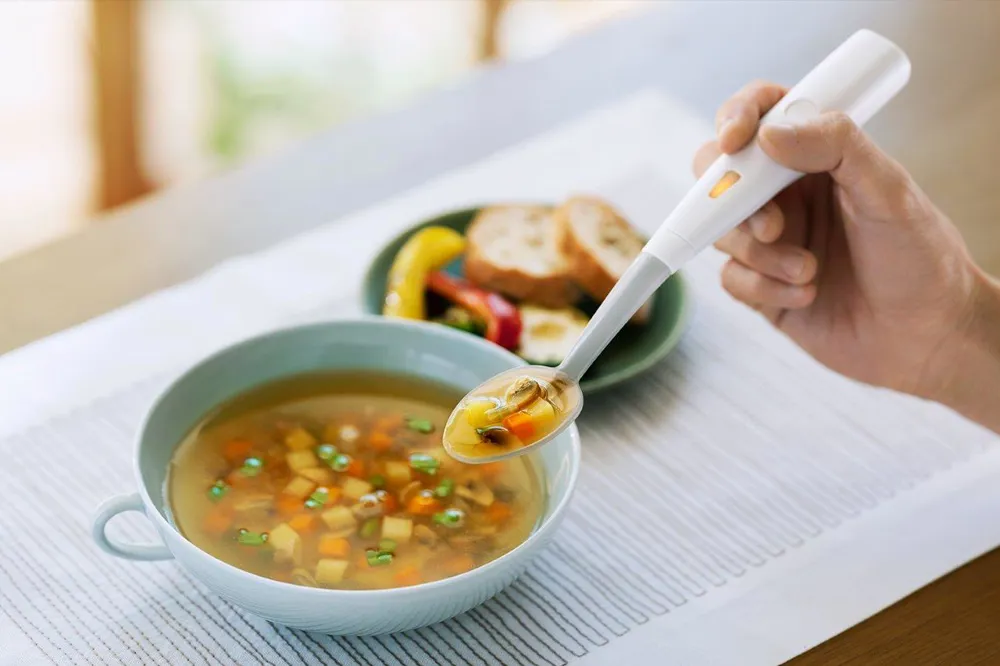
The invention first gained attention in 2023 when Kirin applied for the trademark “electric salt.” The beverage company developed this technology in collaboration with the Japanese Meiji University, Miyashita Laboratory of Frontier Media Science, and the School of Interdisciplinary Mathematical Sciences.
Interestingly, Kirin has filed multiple patent applications across different countries to secure global protection for the invention through a coordinated patent family strategy.
The device won dual honors at the CES Innovation Awards 2025, in the categories of Digital Health and Accessibility & Age Tech.
It’s already on sale in Japan for a little over the equivalent of $100, although Kirin hopes to bring the product to more countries soon.
MIT and Harvard’s sugar-blocking enzymes let you eat sugar without absorbing it
Researchers at MIT and Harvard are addressing the growing health issues associated with high sugar content by utilizing enzyme-polymer conjugated particles. The patent describes a composition that converts sugar into a form that is difficult for the body to digest, thereby reducing the amount of sugar absorbed.
The composition consists of a particle that contains an enzyme to modify the sugar and an inhibitor that prevents the enzyme from activating prematurely. However, once the composition enters the gastrointestinal (GI) tract, environmental conditions, such as pH or ionic strength, trigger the inhibitor to release its hold on the enzyme. This activation enables the enzyme to convert sugar into a polymer that the body cannot absorb easily.
In some cases, polymers derived from sugar, such as fructooligosaccharides, act as prebiotics that promote gut health. This technology can be applied to a variety of foods, including juices, snacks, and bakery products, providing a healthier and more sustainable approach to reducing sugar in everyday diets.
Recommended Read
4. Packaging for temperature, texture, and shelf-life to meet the demands of the rising at-home diners
Your product may be delicious, but can it be delivered to the consumer’s doorstep?
According to the Harris Poll Survey, 89% of U.S. consumers prefer to dine at home instead of eating out to save money. This food trend is attributed to inflation and higher restaurant prices, prompting consumers to seek cost-saving alternatives. This changing behavior is weighing on fast-food chains and restaurants, such as McDonald’s. It saw a 1.1% drop in sales in Q1 2024 in the US due to this trend. Consequently, McDonald’s introduced a $5 value meal to keep customers coming.
This shift is driving the growth of the food delivery market, and it shows no signs of slowing down. To stay relevant, food brands must adapt their products to meet the growing demand for delivery formats.
So, what makes or breaks food products in a delivery-first world?
Among other things, a core challenge turns out to be the packaging.
To stay relevant, brands must:
- Design delivery-optimized formats, rethinking temperature, texture, and shelf-life of the product.
- Create packaging that preserves the experience, not just the product.
Discover how GreyB helped a Fortune 500 FMCG company find a packaging solution that not only withstands low temperatures but also delivers mood-enhancing experiences for consumers.
Local Bounti’s lightweight packaging increases the shelf life of fresh produce 3-5 times
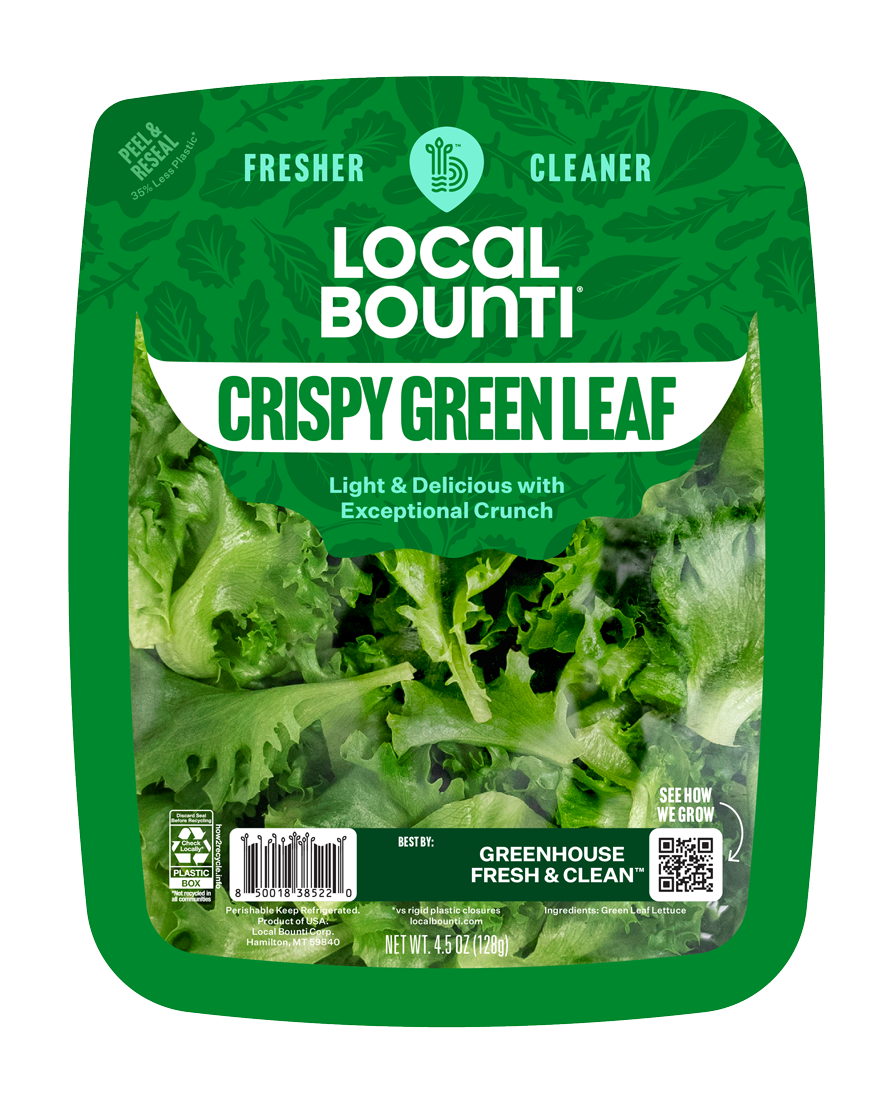
The U.S.-based controlled environment agriculture (CEA) company is transforming the way leafy greens and herbs are produced. Leveraging its patented Stack & Flow Technology™, Local Bounti operates a network of sustainable greenhouses that emphasize freshness, resource efficiency, and proximity to consumers.
Local Bounti has developed an innovative packaging solution for perishable items. This solution features a rigid frame, crafted from durable plastics like PET, with top and bottom flanges that securely seal lightweight films. The result is a protective yet eco-conscious package that cuts material weight by 30–50% compared to conventional hard plastic clamshells.
Designed to be resealable and breathable, the films facilitate gas exchange, a crucial process for perishable products like leafy greens. Additionally, the films allow light to pass through the packaging. This is useful for the growth or preservation of leafy greens stored inside. Local Bounti’s produce has a shelf life that is 3-5 times longer than that of conventionally grown leafy greens.
| Product | Shelf Life |
| Living Butter Lettuce | 14 days |
| Spring Mix | 10 days |
| Romaine Lettuce | 12 days |
This stackable design optimizes storage and transportation, while the lightweight structure further lowers material and shipping costs. The versatile packaging is suitable not only for leafy greens but also for flowers, fresh produce, and other perishable goods. Download our Sustainable Packaging Report to uncover many such breakthrough innovations, brand initiatives, and key players shaping the future of packaging.
Author’s Note: FMCG and food manufacturers looking to capitalize on the growing at-home dining trend should leverage innovations that make home dining both premium and easy. Think gourmet-style frozen entrees, globally inspired meal kits, and high-quality baking mixes that allow anyone to bake artisan bread.
5. Food giants are cutting food waste to comply with regulations
The European Commission is moving forward with a proposal to establish legally binding targets for reducing food waste among EU Member States. By 2030, Member States must:
- Reduce food waste by 10% in the processing and manufacturing stages.
- Reduce food waste by 30% per capita, jointly at both retail and consumer levels (including households and food services), compared to the 2020 baseline.
Such regulatory pressures are forcing the F&B industry to restructure its operations to cut food waste. Since prevention is key, brands are finding innovative ways to improve operations at all stages of production, from farm to fork.
To meet processing and manufacturing targets, food companies need to digitize inventory tracking to better forecast demand and reduce spoilage, as well as invest in upcycling technologies.
Transparent Path’s FreshScore™ Predicts Product Freshness To Avoid Food Spoilage
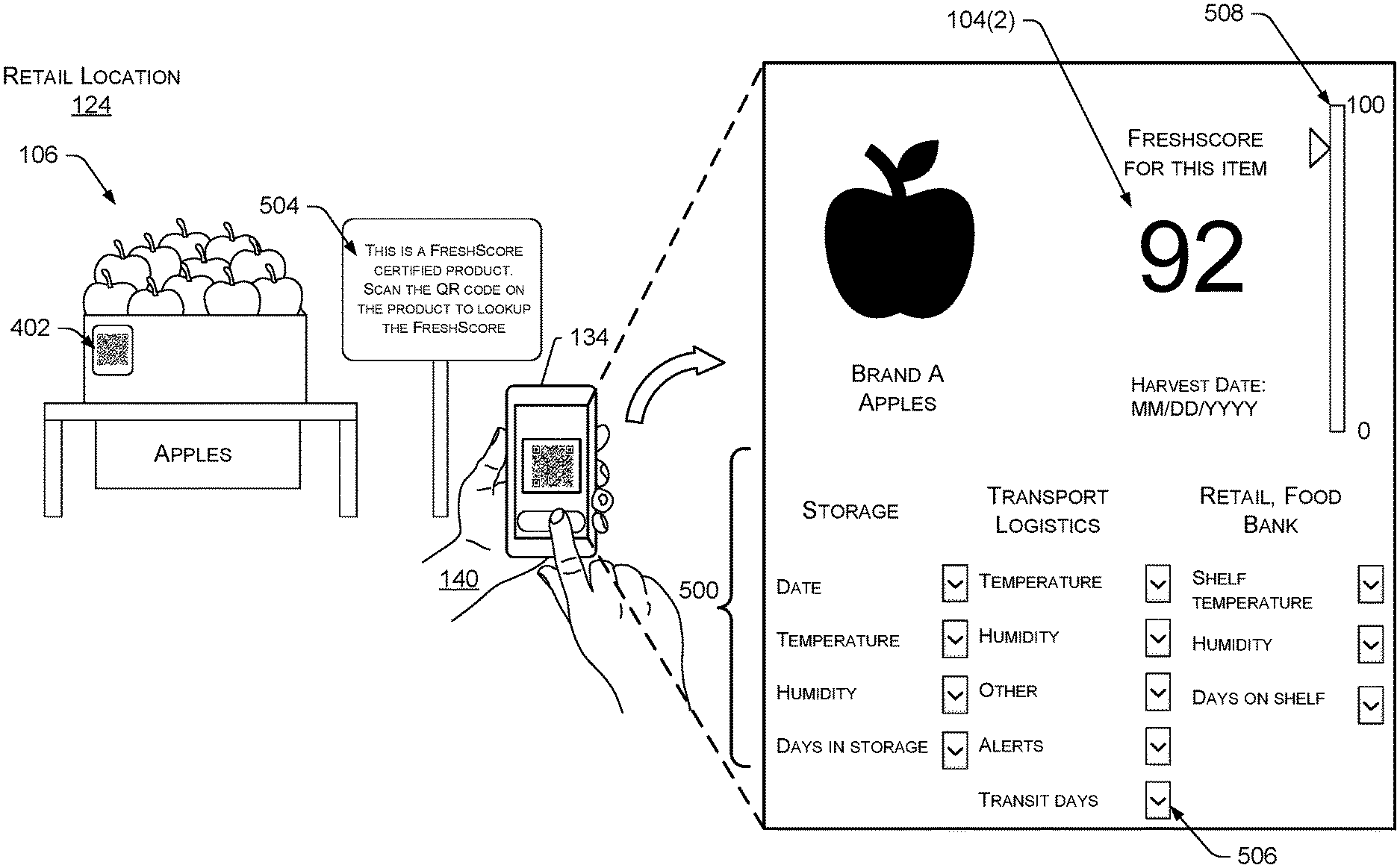
Seattle-based Transparent Path has developed a proprietary algorithm called FreshScore™ to predict the freshness of perishable items, including fruits, vegetables, and dairy products. Its cellular-based ProofTracker™ utilizes real-time data, including temperature, humidity, handling, and transportation history, to understand how storage and movement conditions impact an item’s shelf life. It integrates IoT sensors, AI, and edge computing to monitor shipments continuously.
Users can scan the QR code on the product to look up the freshness score. Stores can use the scores to rotate stock, apply dynamic pricing to aging goods, or discard products likely to spoil soon. It helps reduce food waste, improve safety, and enhance inventory management by indicating the freshness of products.
Dapicon tracks perishable goods in real time to prevent spoilage using sensor and transactional data
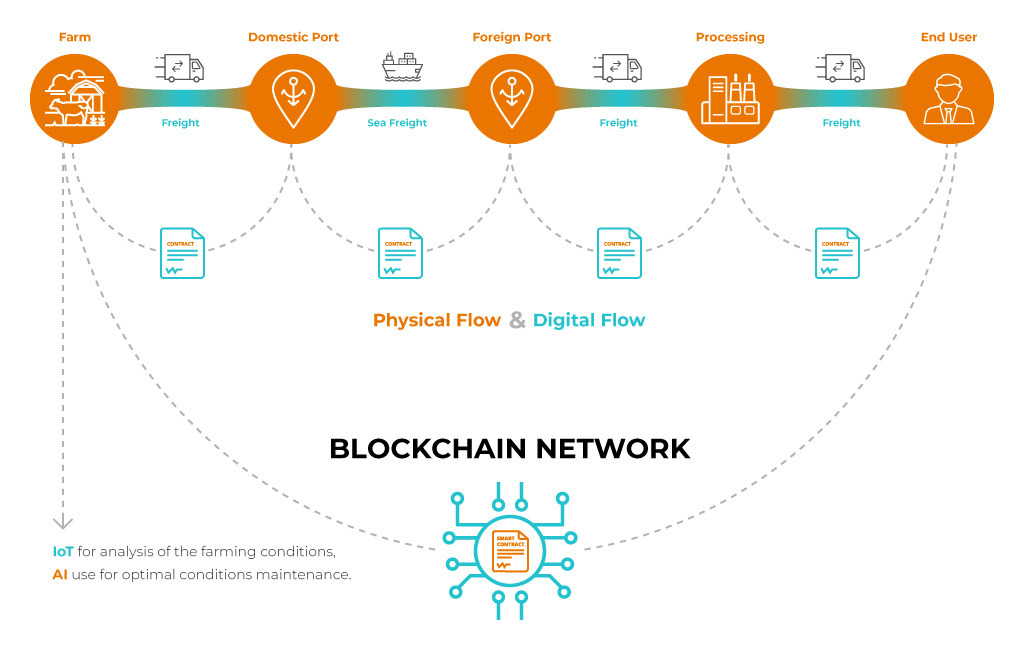
Dapicon Inc.’s patented technology helps track and ensure the quality and safety of perishable commodities as they move from origin to consumer. It works through a centralized repository that combines sensor data (tracking factors like temperature and humidity) and transactional data (e.g., purchase orders, invoices, shipping records) from entities across the supply chain.
The system enables the real-time tracking of critical parameters, including product quality, temperature, and safety, allowing stakeholders to monitor the condition of the goods at every stage. The approach enhances traceability and reduces the wastage of time-sensitive food.
The system supports predictive analytics to forecast future demand, optimize inventory levels, and identify potential disruptions in the supply chain. This enables businesses to plan ahead and manage resources more efficiently.
Discover How Companies Are Upcycling Waste
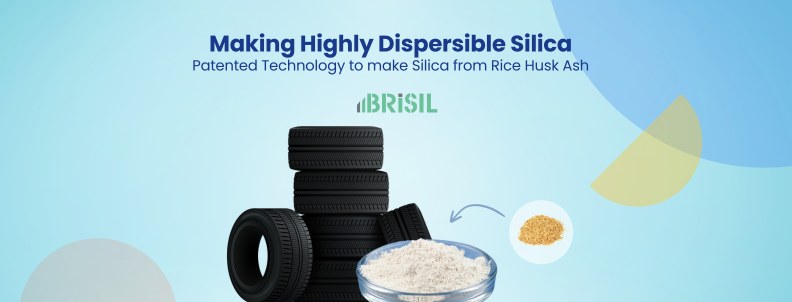
6. GLP-1 users want nutrient-dense meals
The number of users taking GLP-1 medicines for weight management and diabetes increased from 21,000 in 2019 to 174,000 in 2023, marking a 700% rise. These users prefer smaller-portioned snacks and meals that are highly nutrient-dense and can be enjoyed from dinner to breakfast.
From Nestlé’s launch of the Vital Pursuit range to Abbott’s high-protein shakes, several CPG companies are developing new recipes and launching products to meet these needs.
Diet4Life APS’ unique formula uses polypeptides to promote a sense of fullness
Research-based company Diet4Life APS has developed a formula using polypeptides that enhance the release of GLP-1 from intestinal cells, thereby inducing a feeling of fullness. This reduces the user’s food intake, aiding in weight management and preventing obesity and related health issues.
They can be given directly to patients if needed. The invention focuses on utilizing these peptides in nutritional supplements to regulate calorie intake without significantly increasing energy, offering a promising option in GLP-1 foods.
Purdue Research Foundation uses canary seed extracts to suppress hunger
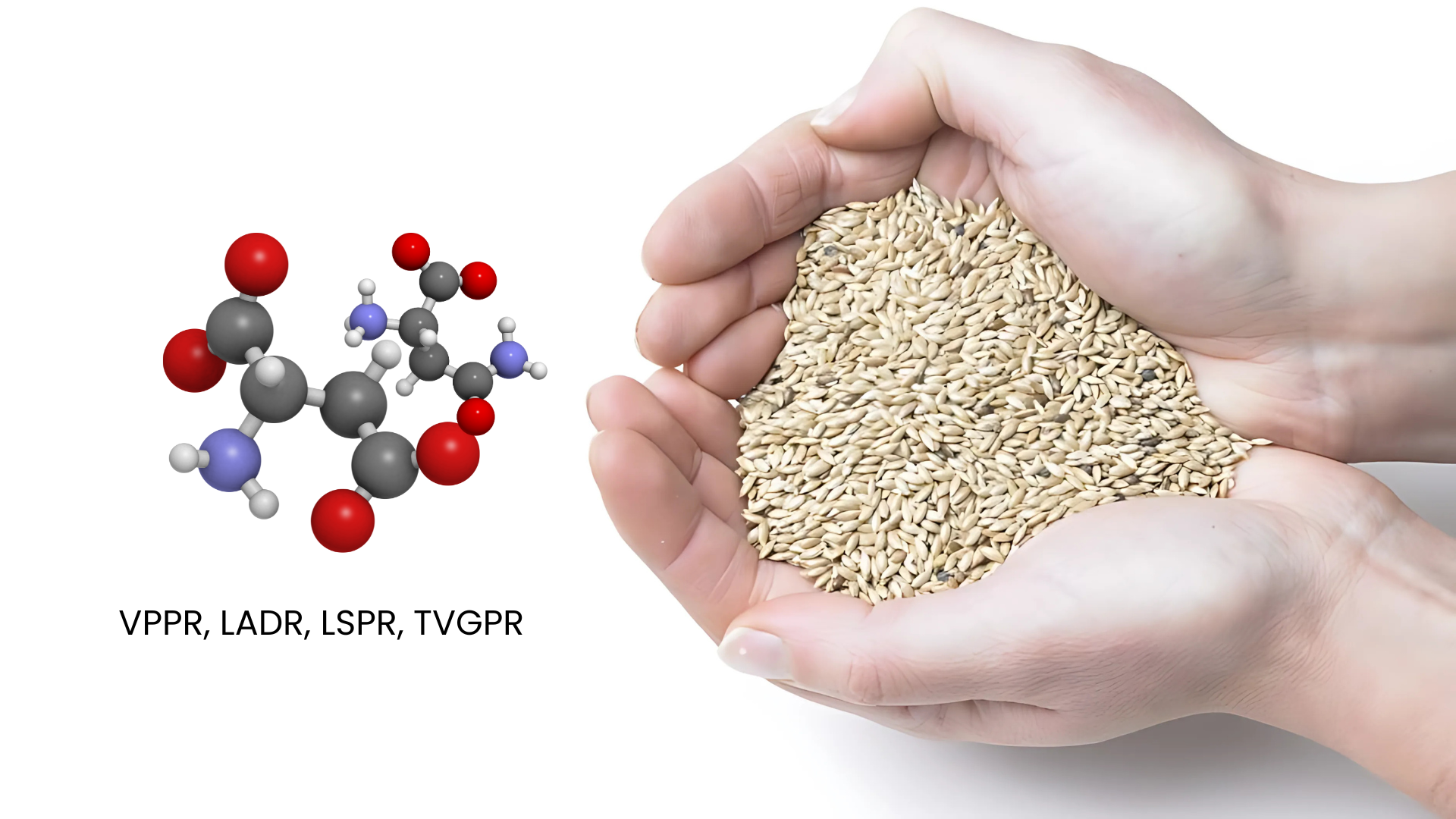
Purdue Research Foundation’s patent introduces a natural, plant-based method to reduce hunger and help manage obesity. The method uses special bioactive peptides extracted from canary seed (Phalaris canariensis L.) to suppress appetite. Users must take a dose of 20–40 mg per kg of body weight per day for effective results.
These peptides are extracted by mixing defatted canary seed flour with water. This is followed by centrifugation, pH level adjustment, enzymatic breakdown using Alcalase®, and pressurized filtration. The peptides obtained from this method contain about 70% crude protein, 1.3% crude fat, and 17% carbohydrates, which contribute to their effective properties.
In addition to suppressing hunger, this innovation enhances glucose tolerance and prevents weight gain, making it a promising option for managing obesity.
7. Brands are hoarding alt-protein patents, a striking 960% surge in filings over the past decade
Alternative protein patents have surged by an impressive 960% over the past decade. Industry giant Nestlé tops the charts with the most patents published (744). Here are the top five companies with the most patents in the alternative protein space.
| Name of Company | Patents in the alternative protein domain (2015-2025) |
| Nestlé | 744 |
| Roquette Frères | 324 |
| DSM-Firmenich | 221 |
| Unilever | 210 |
| Givaudan | 142 |
In June 2025, Impossible Foods announced its entry into the blended meat space with a hybrid burger that combines plant-based and meat ingredients. This strategic shift is to capitalize on the growing number of flexitarians in the US. Impossible Foods recognized that a purely plant-based diet remains a niche. Nearly 72 million U.S. households that bought vegan meat also purchased conventional meat within the same timeframe in 2024. Impossible Foods CEO Peter McGuinness revealed that capturing even a “sizeable portion” of this flexitarian market could potentially quadruple the company’s revenue.
Upside Foods is using plant fat-based scaffolds for growing cell-based alternative meats
Lab-grown or cultured meat aims to reduce the negative impacts of traditional meat production on humans, animals, and the environment. It involves growing muscle fibers in the lab using suitable cells and growth media.
However, the industry faces various challenges in growing and processing cultured meat. One of these is developing scaffolds, which are structures that support cell growth and fusion. Current scaffolds are often made from non-edible, medical-grade materials, which must be removed before consumption. The removal processes are costly and time-consuming.
Upside Foods has introduced plant-based scaffolds to solve this industry challenge. The scaffold supports various animal cells, including muscle, skin, or fat-derived cells, such as myoblasts, myocytes, and mesenchymal stem cells, among others. These scaffolds can either be consumed with the cell-based meat or melted away and recycled into raw material for future scaffold production. This makes the process more efficient and sustainable.
Upside Foods has secured significant investments from Bill Gates, John Doerr, Kimbal & Christiana Musk, among others. This reflects strong market confidence in its innovative approach.
Air Protein Inc. uses CO2 to develop high-protein meat substitutes
Air Protein’s patented technology uses chemoautotrophic microorganisms to develop a high-protein meat substitute. These microorganisms grow by utilizing CO2, making the process sustainable. This alternative, protein-rich food resembles the texture, flavor, and functional properties of animal meat.
The company has secured $107 million in funding from prominent investors, including ADM Ventures, Barclays, and Google Ventures (GV).
The process utilizes protein products from microorganisms, including single-cell proteins, cell lysates, protein hydrolysates, free amino acids, peptides, and oligopeptides. It is free from animal-derived proteins, fats, and carbohydrates, making it suitable for plant-based and vegan diets.
Author’s Note: Air Protein has a strong IP portfolio of over 49 patents for this technology. Here’s a detailed breakdown of Air Protein Patents.
Future Outlook
The future of food is being shaped by what people want in their everyday lives, meals that are healthier, more convenient, and made just for them. Parents are choosing brands like Cerebelly and Brainiac Foods that promise smarter nutrition for their kids. These companies are tapping into the growing demand for food that supports children’s brain and body development.
There’s also a clear rise in high-protein foods. Brands have begun highlighting the protein content on the packaging of their products to cater to this demand. R&D heads must evaluate innovations in these areas across several factors, including TRLs, scalability, cost efficiency, and potential implementation challenges, to ensure smooth integration into their business.
Talk to our experts to get a comprehensive assessment of innovative solutions that can help you capitalize on the future food trends.
Talk To Our Experts Today
Fill out the form below

